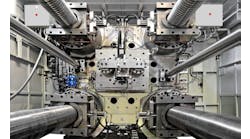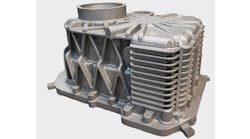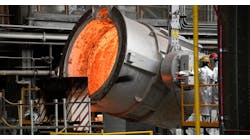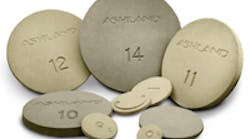For years foundries have used various different materials — from silica sand, to rice hulls, to insulating and exothermic material blends — to cover the tops of open risers in an effort to help reduce heat loss from the top of the riser into the atmosphere, thereby improving the performance of the riser.
These materials are known as “hot toppings” because they keep the top of the riser hot while the casting solidifies. Ashland has developed low-density aluminum-silicate ceramics for use in its line of EXACTCAST® riser sleeves and core and mold components, and now this technology is being used to create insulating and exothermic Floating Cover Lids (FCL) to replace the traditional hot topping materials — a different application that shows vastly improved results.
Metalcasting is notable for its array of process variables, all of which influence the quality of finished castings. One way to improve any process is to remove as many variables as possible, making the operation more consistent. Hot toppings can be made in various formulations, many of which are specifically formulated for the type of metal being poured and the size of the riser. Typically the recommended amount of a powdered hot topping material is a layer equivalent to approximately 10% of the riser’s diameter, or a minimum thickness of about 0.50 in., whichever is greater.
However, many times it is easier to just fill a container and dump the topping on the metal in the riser after the mold is poured. Instead of having a different container for each riser size, typically a common container is used for all sizes. If less topping is needed for a smaller riser the decision is left to individual discretion. If more is needed, multiple scoops of hot topping may be applied. Rarely is the amount of hot topping optimized for the specific riser in which it is applied.
The time between when the metal enters the mold and when the hot topping material is applied is critical. If too much time elapses, a skin can form on the top of the riser, reducing its ability to pipe down and feed the riser. An inadequate amount of hot topping material can cause a similar problem. There is also an assumption that all of the hot topping material poured onto the top of the metal actually lands and stays on top of the metal. Unfortunately, many times this does not happen. Sometimes, in the rush to get the material on top of the riser, a portion of the material spills off onto the top of the mold. In foundries where cooling fans sit next to the molds being poured, the flow of air can blow hot topping material off the riser.
Floating Cover Lids can be placed in the riser cavity prior to pouring, and provide an immediate insulating and/or exothermic cover for the metal as the metal enters the riser cavity. This minimizes the radiant and convection heat losses from the metal, and helps maintain molten metal’s temperature, thereby maximizing the riser’s feeding capabilities. The FCL shape and size can be optimized for the specific riser in which it will be used thus eliminating waste and, at the same time, guarantee that the proper amount of material is being applied every time. The current line of EXACTCAST Floating Cover Lids ranges in sizes that fit risers from 3 to 22 in. diameter.
The preferred method of application is to place the FCL inside the riser after the mold is closed. This provides additional protection from dirt and debris, which could fall into the casting cavity as the mold sits in the foundry waiting to be poured. In order to keep the FCL from falling into the casting cavity there needs to be suitable support, such as sleeves fitted with a Washburn breaker core, or where the feeder has a “necked down” contact with the casting.
When straight cylindrical risers are used there is nothing within the riser cavity to hold the FCL in place and keep it from falling into the casting cavity. Foundries simply place the FCL on the rising metal after it has started entering the riser cavity during the casting pour. Some find it convenient to place rods or nails across the inside of the sleeve to provide support for the FCL when straight cylindrical sleeves are used. This optimizes the benefits that the FCL offers.
Both lab and field trials confirmed the benefits FCLs:
Consistency
• Provides a controlled and consistent amount of topping.
• Provides a natural vent so molds fill easier.
Contamination
• Helps prevent debris from getting into the mold cavity while waiting to be poured.
• Blocks incidental metal splashes from falling into the casting cavity during the pour.
• Eliminates the potential for sand contamination that occurs when powdered hot toppings are inadvertently scattered over the top of cores instead of into the feeder cavities.
Timing
• Allows for the placement within the riser cavity prior to mold filling, eliminating the need to apply a topping after the mold is poured.
• Immediately covers the metal as it enters the riser cavity, eliminating inefficiencies related to the late addition of traditional hot topping materials.
Environmental
• Eliminates nuisance dust generated when powdered hot toppings are applied.
• Reduces the amount of smoke generated compared to some hot topping materials.
Ashland’s EXACTCAST Floating Cover Lids can dramatically improve the consistency of a riser’s feeding efficiency. Many of the foundry variables are eliminated when FCLs are used, such as: how much hot topping was used, when was it applied, and did it really cover the riser evenly. Lab and foundry tests confirm the overall performance and consistency improvements when EXACTCAST FCLs are used compared to the use of traditional hot topping materials.
Ron Aufderheide is a principal development engineer, global technology, with Ashland Casting Solutions.









